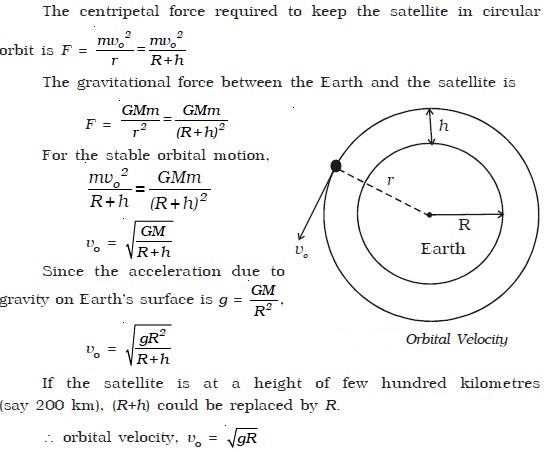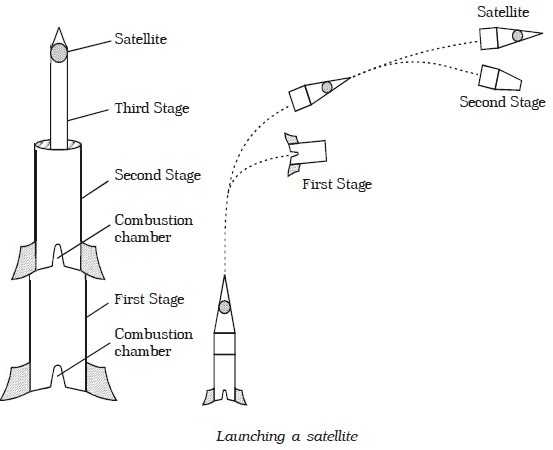Satellites
A body moving in an orbit around a planet is called satellite. The moon is the natural satellite of the Earth. It moves around the Earth once in 27.3 days in an approximate circular orbit of radius 3.85 × 105 km.
Orbital velocity
Artificial satellites are made to revolve in an orbit at a height of few hundred kilometres. At this altitude, the friction due to air is negligible. The satellite is carried by a rocket to the desired height and released horizontally with a high velocity, so that it remains moving in a nearly circular orbit. The horizontal velocity that has to be imparted to a satellite at the determined height so that it makes a circular orbit around the planet is called orbital velocity. Let us assume that a satellite of mass m moves around the Earth in a circular orbit of radius r with uniform speed vo. Let the satellite be at a height h from the surface of the Earth. Hence, r = R+h, where R is the radius of the Earth.

If the horizontal velocity (injection velocity) is not equal to the calculated value, then the orbit of the satellite will not be circular. If the injection velocity is greater than the calculated value but not greater than the escape speed (ve = 2 vo), the satellite will move along an elliptical orbit. If the injection velocity exceeds the escape speed, the satellite will not revolve around the Earth and will escape into the space. If the injection velocity is less than the calculated value, the satellite will fall back to the Earth.
Time period of a satellite
Time taken by the satellite to complete one revolution round the Earth is called time period.

Energy of an orbiting satellite
A satellite revolving in a circular orbit round the Earth possesses both potential energy and kinetic energy. If h is the height of the satellite above the Earth’s surface and R is the radius of the Earth, then the radius of the orbit of satellite is r = R+h.
If m is the mass of the satellite, its potential energy is,


Geo–stationary satellites
A geo-stationary satellite is a particular type used in television and telephone communications. A number of communication satellites which appear to remain in fixed positions at a specified height above the equator are called synchronous satellites or geo-stationary satellites. Some television programmes or events occuring in other countries are often transmitted ‘live’ with the help of these satellites. For a satellite to appear fixed at a position above a certain place on the Earth, its orbital period around the Earth must be exactly equal to the rotational period of the Earth about its axis. Consider a satellite of mass m moving in a circular orbit around the Earth at a distance r from the centre of the Earth. For synchronisation, its period of revolution around the Earth must be equal to the period of rotation
of the Earth (ie) 1 day = 24 hr = 86400 seconds.


Substituting T = 86400 s, R = 6400 km and g = 9.8 m/s2, the radius of the orbit of geo-stationary satellite is calculated as 42400 km.
∴ The height of the geo-stationary satellite above the surface of the Earth is h = r − R = 36000 km.
If a satellite is parked at this height, it appears to be stationary. Three satellites spaced at 120o intervals each above Atlantic, Pacific and Indian oceans provide a worldwide communication network.
Polar satellites
The polar satellites revolve around the Earth in a north−south orbit passing over the poles as the Earth spins about its north − south axis.
The polar satellites positioned nearly 500 to 800 km above the Earth travels pole to pole in 102 minutes. The polar orbit remains fixed in space as the Earth rotates inside the orbit. As a result, most of the earth’s surface crosses the satellite in a polar orbit. Excellent coverage of the Earth is possible with this polar orbit. The polar satellites are used for mapping and surveying.
Uses of satellites
Satellite communication
Communication satellites are used to send radio, television and telephone signals over long distances. These satellites are fitted with devices which can receive signals from an Earth – station and transmit them in different directions.
Weather monitoring
Weather satellites are used to photograph clouds from space and measure the amount of heat reradiated from the Earth. With this information scientists can make better forecasts about weather. You might have seen the aerial picture of our country taken by the satellites, which is shown daily in the news bulletin on the television and in the news papers.
Remote sensing
Collecting of information about an object without physical contact with the object is known as remote sensing. Data collected by the remote sensing satellities can be used in agriculture, forestry, drought assessment, estimation of crop yields, detection of potential fishing zones, mapping and surveying.
Navigation satellites
These satellites help navigators to guide their ships or planes in all kinds of weather.
Indian space programme
India recognised the importance of space science and technology for the socio-economic development of the society soon after the launch of Sputnik by erstwhile USSR in 1957. The Indian space efforts started in 1960 with the establishment of Thumba Equatorial Rocket Launching Station near Thiruvananthapuram for the investigation of ionosphere. The foundation of space research in India was laid by Dr. Vikram Sarabai, father of the Indian space programme. Initially, the space programme was carried out by the Department of Atomic Energy. A separate Department of Space (DOS) was established in June 1972. Indian Space Research Organisation (ISRO) under DOS executes space
programme through its establishments located at different places in India (Mahendragiri in Tamil Nadu, Sriharikota in Andhra Pradesh, Thiruvananthapuram in Kerala, Bangalore in Karnataka, Ahmedabad in Gujarat, etc…). India is the sixth nation in the world to have the capability of designing, constructing and launching a satellite in an Earth orbit. The main events in the history of space research in India are given below:
Weightlessness
Television pictures and photographs show astronauts and objects floating in satellites orbiting the Earth. This apparent weightlessness is sometimes explained wrongly as zero–gravity condition. Then, what should be the reason?
Consider the astronaut standing on the ground. He exerts a force (his weight) on the ground. At the same time, the ground exerts an equal and opposite force of reaction on the astronaut. Due to this force of reaction, he has a feeling of weight.
When the astronaut is in an orbiting satellite, both the satellite and astronaut have the same acceleration towards the centre of the Earth. Hence, the astronaut does not exert any force on the floor of the satellite. So, the floor of the satellite also does not exert any force of reaction on the astronaut. As there is no reaction, the astronaut has a feeling of weightlessness.
Rockets − principle
A rocket is a vehicle which propels itself by ejecting a part of its mass. Rockets are used to carry the payloads (satellites). We have heard of the PSLV and GSLV rockets. All of them are based on Newton’s third law of motion. Consider a hollow cylindrical vessel closed on both ends with a small hole at one end, containing a mixture of combustible fuels (Fig. below). If the fuel is ignited, it is converted into a gas under high pressure. This high pressure pushes the gas through the hole with an enormous force. This force represents the action A. Hence an opposite force,which is the reaction R, will act on the vessel and make it to move forward. The force (Fm) on the escaping mass of gases and hence the rocket is proportional to the product of the mass of the gases discharged per unit time (dm/dt) and the velocity with which they are expelled (v)


This force is known as momentum thrust. If the pressure (Pe) of the escaping gases differs from the pressure (Po) in the region outside the rocket, there is an additional thrust called the velocity thrust (Fv) acts. It is given by Fv = A (Pe − Po) where A is the area of the nozzle through which the gases escape. Hence, the total thrust on the rocket is F = Fm + Fv
Types of fuels
The hot gases which are produced by the combustion of a mixture of substances are called propellants. The mixture contains a fuel which burns and an oxidizer which supplies the oxygen necessary for the burning of the fuel. The propellants may be in the form of a solid or liquid.
Launching a satellite
To place a satellite at a height of 300 km, the launching velocity should atleast be about 8.5 km s–1 or 30600 kmph. If this high velocity is given to the rocket at the surface of the Earth, the rocket will be burnt due to air friction. Moreover, such high velocities cannot be developed by single rocket. Hence, multistage rockets are used.To be placed in an orbit, a satellite must be raised to the desired height and given the correct speed and direction by the launching rocket (Fig. below). At lift off, the rocket, with a manned or unmanned satellite on top, is held down by clamps on the launching pad. Now the exhaust gases built−up an upward thrust which exceeds the rocket’s weight. The clamps are then removed by remote control and the rocket accelerates upwards.

To penetrate the dense lower part of the atmosphere, initially the rocket rises vertically and then tilted by a guidance system. The first stage rocket, which may burn for about 2 minutes producing a speed of 3 km s–1, lifts the vehicle to a height of about 60 km and then separates and falls back to the Earth. The vehicle now goes to its orbital height, say 160 km, where it moves horizontally for a moment. Then the second stage of the rocket fires and increases the speed that is necessary for a circular orbit. By firing small rockets with remote control system, the satellite is separated from the second stage and made to revolve in its orbit.

